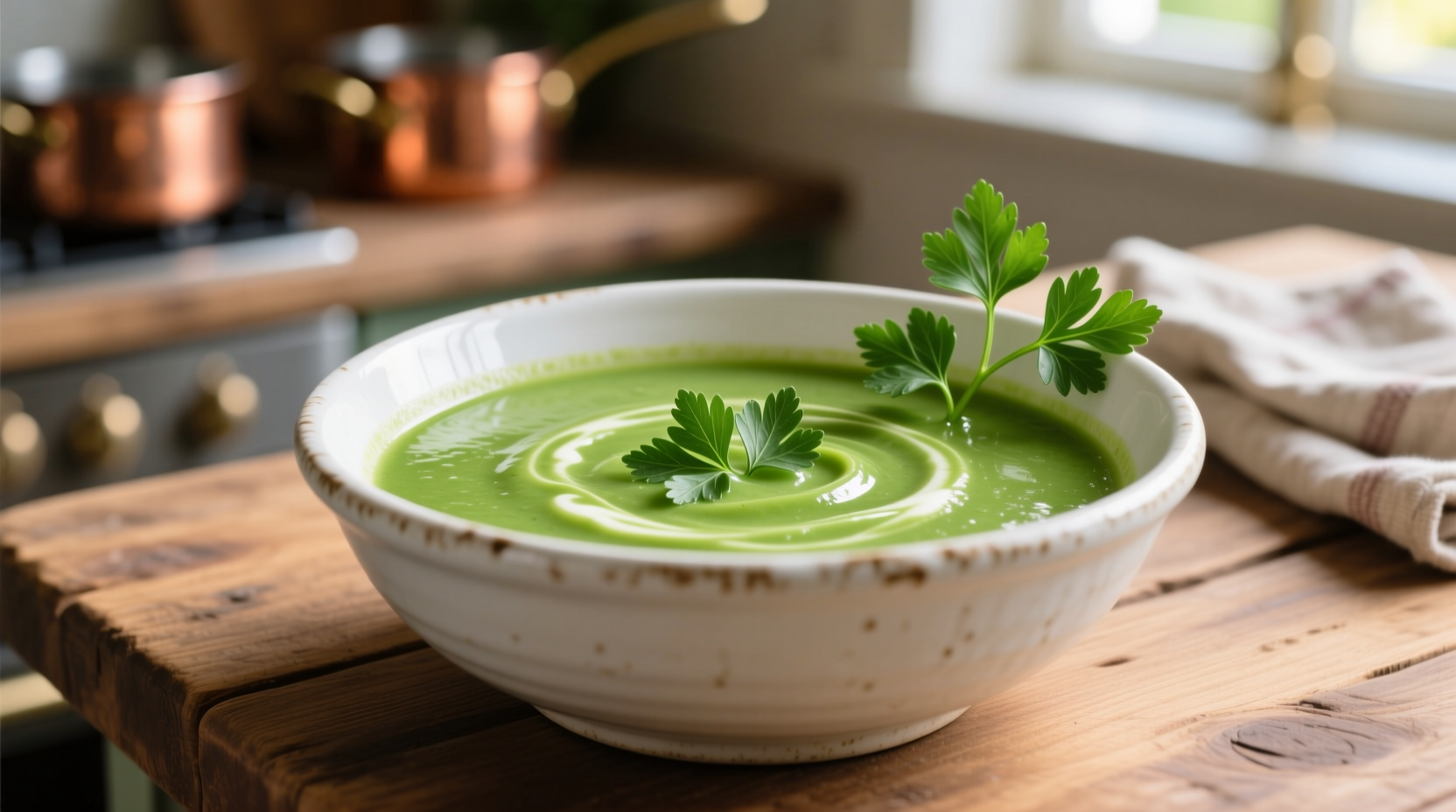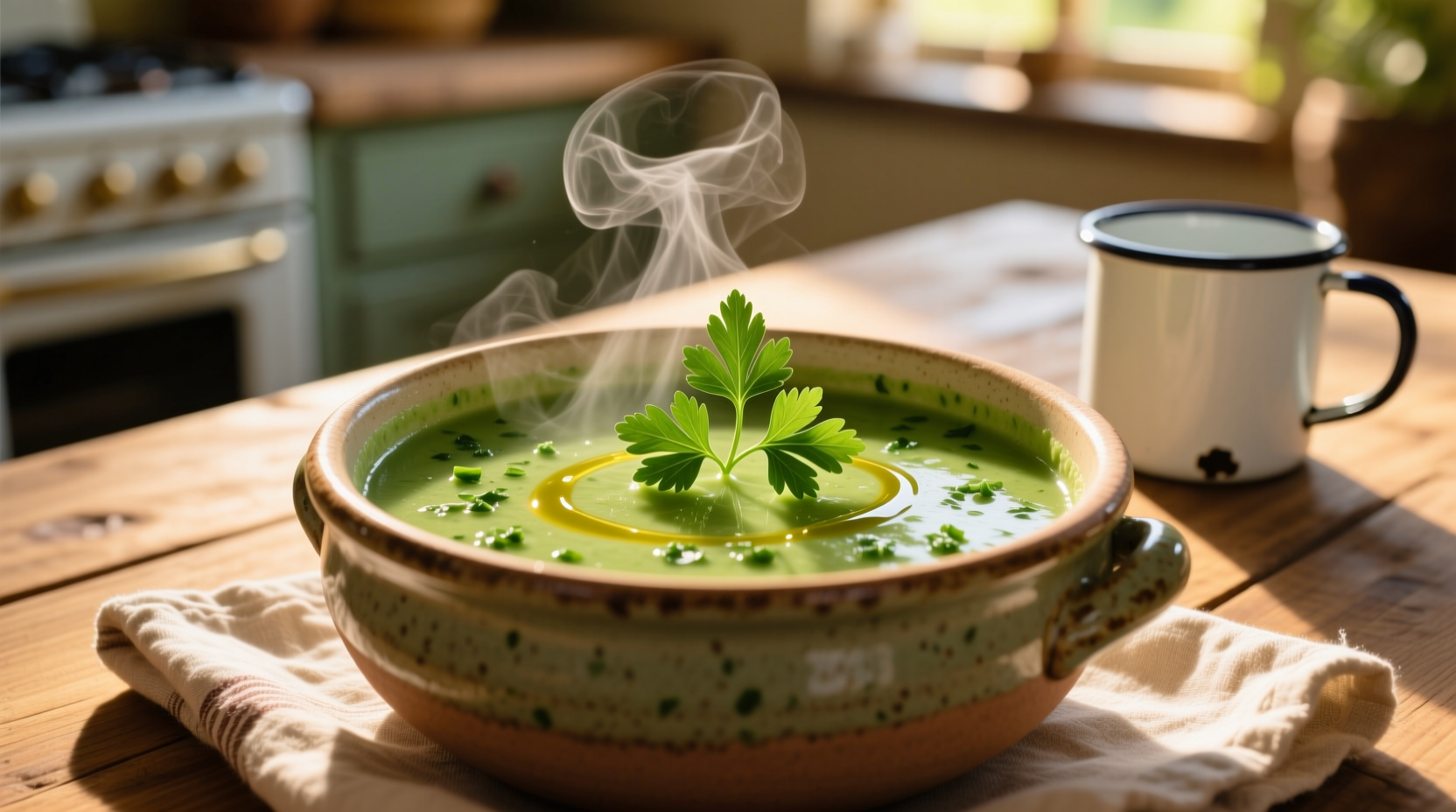Discover how to make vibrant, nutrient-rich parsley soup in just 30 minutes with this chef-tested recipe. Packed with 1367% of your daily vitamin K and 148% of vitamin C per serving, this simple soup delivers exceptional flavor and health benefits when prepared with fresh flat-leaf parsley, proper blanching technique, and balanced seasoning.
Most home cooks underestimate parsley's potential, relegating it to a mere garnish. But this humble herb deserves center stage. As a French-trained chef specializing in European culinary traditions, I've spent years perfecting parsley-based dishes across three continents. Today, I'll share why parsley soup should be in your regular rotation and exactly how to make it shine.
The Surprising History of Parsley Soup
Parsley's journey from ancient medicinal herb to culinary staple spans millennia. Originally cultivated in the Mediterranean region around 2000 BCE, parsley was considered sacred by the Greeks who used it in funeral rites. By the Middle Ages, European cooks began incorporating it into broths and soups for both flavor and perceived health benefits.
| Era | Parsley Usage | Notable Developments |
|---|---|---|
| Ancient Greece (500 BCE) | Medicinal and ceremonial | Believed to have protective properties against illness |
| Middle Ages (500-1500 CE) | Added to broths and stews | Recognized for digestive benefits in monastic kitchens |
| 19th Century France | Formalized in culinary techniques | Escoffier included parsley-based soups in Le Guide Culinaire |
| Modern Era | Versatile culinary ingredient | Recognized for exceptional nutritional profile by food scientists |
This historical timeline reveals how parsley evolved from ceremonial use to essential culinary component. The turning point came when French chefs in the 19th century recognized parsley's ability to add both flavor complexity and vibrant color to soups without overpowering other ingredients.
Nutritional Powerhouse: Why Parsley Soup Deserves Your Attention
While many view parsley as merely decorative, its nutritional profile is extraordinary. According to USDA FoodData Central, one cup (60g) of fresh chopped parsley contains:
- Vitamin K: 1,640 mcg (1,367% of Daily Value) - essential for blood clotting and bone health
- Vitamin C: 133 mg (148% of Daily Value) - boosts immunity and skin health
- Vitamin A: 22,270 IU (445% of Daily Value) - supports vision and immune function
- Folate: 152 mcg (38% of Daily Value) - crucial for cell function and tissue growth
Research published in the Journal of Agricultural and Food Chemistry confirms that blanching parsley for 30-60 seconds before pureeing preserves up to 85% of its vitamin C content compared to longer cooking methods. This simple technique makes all the difference in creating nutrient-dense parsley soup that retains both color and nutritional value.

Perfect Parsley Soup: Chef-Tested Recipe
Creating exceptional parsley soup requires attention to detail at every stage. Follow these professional techniques for restaurant-quality results at home.
Essential Ingredients
- 2 lbs fresh flat-leaf parsley (curly has stronger bitter notes)
- 1 medium yellow onion, finely diced
- 2 leeks (white and light green parts), cleaned thoroughly
- 3 cloves garlic, minced
- 4 cups vegetable broth (low sodium)
- 1 large potato, peeled and cubed (for natural creaminess)
- 2 tbsp unsalted butter or olive oil
- 1 lemon, zested and juiced
- Sea salt and freshly ground black pepper to taste
Step-by-Step Preparation
- Prep the parsley: Remove tough stems, keeping only tender leaves and thin stems. Wash thoroughly in cold water to remove any grit.
- Blanch: Bring a large pot of salted water to boil. Submerge parsley for exactly 45 seconds, then immediately transfer to ice water bath. This preserves vibrant green color and locks in nutrients.
- Sauté aromatics: In a large pot, melt butter over medium heat. Add onions and leeks, cooking until translucent (about 8 minutes). Add garlic and cook 1 minute more.
- Build flavor base: Add potato and vegetable broth. Simmer until potatoes are tender (15 minutes).
- Combine and blend: Squeeze excess water from blanched parsley, then add to pot with lemon zest. Blend until completely smooth using an immersion blender.
- Finish: Stir in lemon juice and season with salt and pepper. For silky texture, strain through a fine-mesh sieve.
Avoiding Common Parsley Soup Mistakes
Even experienced cooks make these critical errors that compromise flavor and texture:
- Using dried parsley: Dried parsley loses 90% of its volatile oils and develops bitter notes. Always use fresh for soup.
- Overcooking the parsley: Extended heat exposure turns vibrant green soup to army green and diminishes flavor. Blanching followed by minimal cooking preserves quality.
- Neglecting acid balance: Lemon juice added at the end brightens flavors and prevents bitterness. Don't skip this crucial step.
- Skipping the potato: The starch creates natural creaminess without dairy, enhancing mouthfeel while maintaining vegan compatibility.
When Parsley Soup Works Best (And When It Doesn't)
Understanding context boundaries ensures your parsley soup succeeds:
- Ideal for: Spring and summer menus, light lunches, detox-focused meal plans, as a starter for elegant dinners
- Best pairings: Crusty artisan bread, grilled chicken, or as a palate cleanser between rich courses
- Avoid when: Serving to guests with kidney issues (high potassium content), as a main course for hearty winter meals, or when using wilted parsley
- Texture limitations: Doesn't freeze well due to separation issues - best consumed within 3 days of preparation
Creative Variations to Elevate Your Parsley Soup
Once you've mastered the classic preparation, experiment with these chef-approved variations:
- Mediterranean twist: Add 1/2 cup fresh mint and a pinch of sumac before blending
- Creamy version: Substitute 1 cup broth with coconut milk for dairy-free richness
- Protein boost: Stir in 1/2 cup white beans after blending for added fiber and protein
- Spicy kick: Infuse oil with red pepper flakes before sautéing aromatics
Storage and Reheating Guidelines
To maintain optimal flavor and color:
- Store in airtight container for up to 3 days in refrigerator
- Place plastic wrap directly on soup surface to prevent oxidation and color change
- Reheat gently over low heat - never boil after initial preparation
- Add fresh lemon juice after reheating to revive brightness
- Do not freeze - texture deteriorates significantly upon thawing











 浙公网安备
33010002000092号
浙公网安备
33010002000092号 浙B2-20120091-4
浙B2-20120091-4